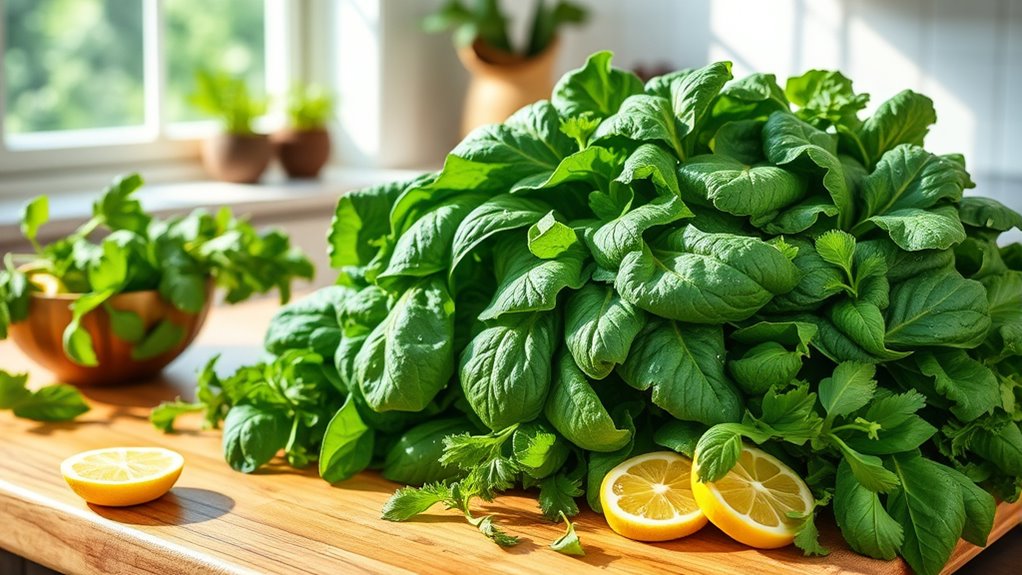Leafy greens are not just nutritious; they can be incredibly delicious too! Incorporate kale, spinach, or arugula into salads, smoothies, or soups for a taste boost. These greens offer essential vitamins, minerals, and fiber while keeping calories low. Experiment with sweet strawberries and tart feta in a spinach salad or add collard greens to hearty soups for extra flavor and nutrition. Discover exciting ways to enjoy these greens that’ll inspire you to make healthier choices.
Key Takeaways
- Incorporate nutrient-rich leafy greens like kale, spinach, and arugula into salads for added flavor and health benefits.
- Try mixing spinach into smoothies for a nutritious boost without altering the taste.
- Experiment with hearty soups featuring collard greens or Swiss chard to enhance nutrition and satisfaction.
- Combine greens with ingredients like beets, walnuts, or strawberries for delicious salad variations.
- Use fresh, seasonal greens and store them properly to maintain their crunch and nutrients.
The Nutritional Power of Leafy Greens

Leafy greens pack a powerful nutritional punch that can transform your diet. These vibrant vegetables are packed with nutrients, making them crucial for your health.
One standout nutrient is vitamin K; just one cup of raw endive delivers an impressive 97% of your Daily Value, essential for blood clotting and bone health. Leafy greens also provide vitamin A for eye health and vitamin C to boost your immune system.
Leafy greens, rich in vitamin K, are vital for blood clotting and bone health, while also boosting your immune system.
Plus, they’re low in calories yet high in fiber, promoting fullness and aiding weight management. With minerals like calcium and iron, leafy greens support bone health and oxygen transport.
Incorporating a mix of raw and cooked greens can enhance your antioxidant levels, combat oxidative stress, and reduce inflammation, offering numerous health benefits.
Top Leafy Greens to Include in Your Diet
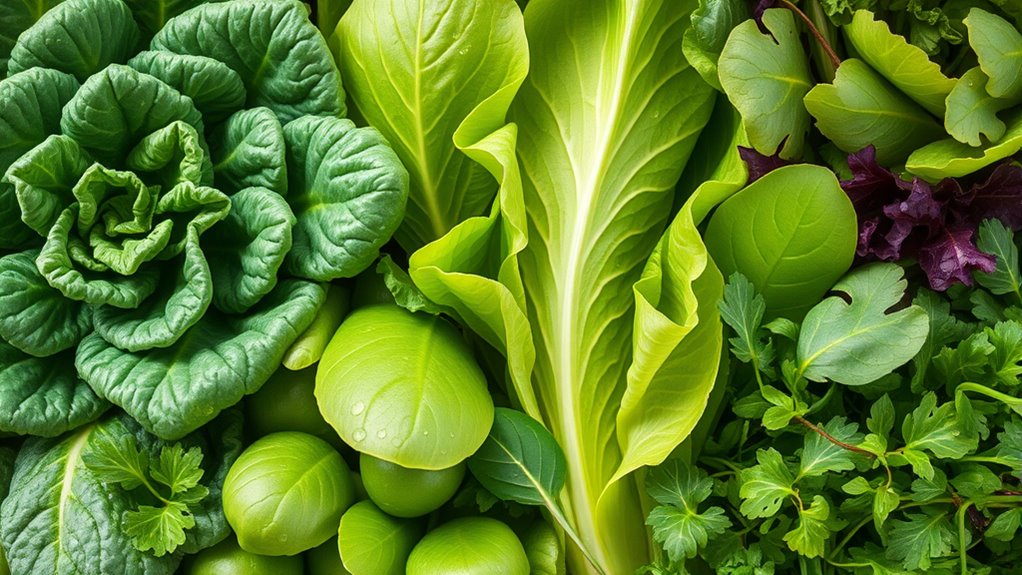
When it comes to leafy greens, you’re in for a treat with some of the most nutrient-dense options around.
Kale, spinach, collard greens, arugula, and Swiss chard all pack a powerful punch of vitamins and minerals while offering versatile ways to enjoy them in your meals.
Let’s explore how to incorporate these delicious greens into your diet for maximum health benefits!
Nutritional Powerhouses
Including nutrient-dense leafy greens in your diet can greatly boost your overall health and well-being. Nutritional powerhouses like kale, spinach, and collard greens are packed with essential vitamins A, C, and K, which support immune function and bone health.
Just one cup of raw spinach provides nearly 20% of your daily iron needs, helping prevent anemia, especially in older adults. Collard greens deliver nearly 100% of your daily value for vitamin K, vital for bone health and blood clotting.
Arugula is another fantastic choice, rich in antioxidants like kaempferol that may reduce inflammation and lower chronic disease risk. By incorporating a variety of leafy greens, you’ll benefit from a diverse range of phytonutrients that promote overall health.
Versatile Culinary Uses
There’s no denying the versatility of leafy greens in your kitchen, as they can elevate a variety of dishes. You can enjoy their robust flavors and health benefits in countless ways, making them a culinary staple.
Consider these options:
- Salads: Kale and arugula create a flavorful base that’s perfect for hearty salads.
- Smoothies: Spinach blends seamlessly into smoothies, adding nutrients without overpowering other flavors.
- Stir-fries: Collard greens and Swiss chard can be cooked slowly, enhancing their flavors in soups and stir-fries.
Incorporating a variety of leafy greens like romaine and beet greens not only adds different textures but also boosts your meals’ nutrient density, providing essential vitamins and minerals for overall health.
Creative Ways to Prepare Leafy Greens
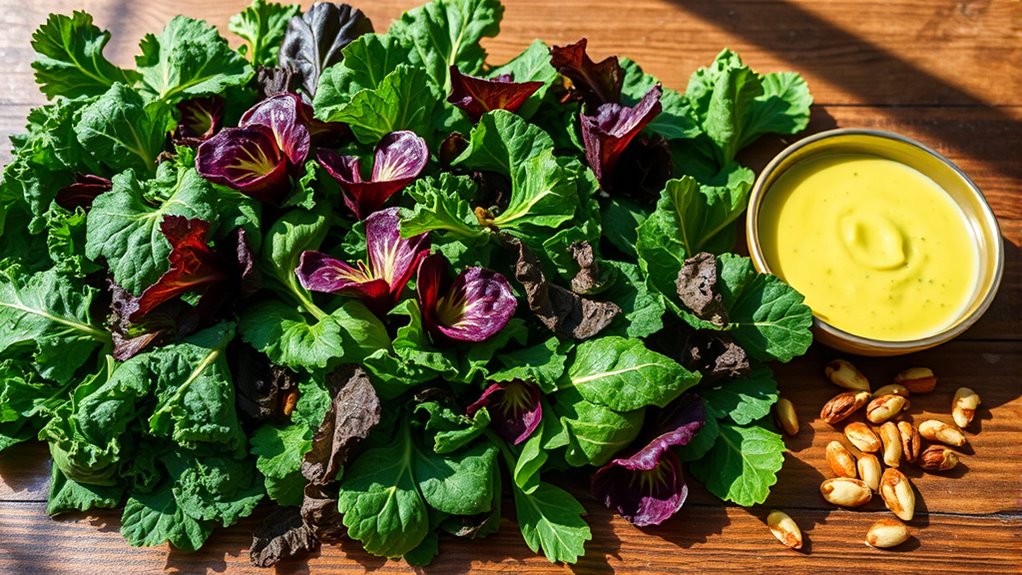
If you’re looking to add more leafy greens to your meals, there are plenty of creative ways to prepare them that make eating healthy enjoyable.
Blend kale or spinach into smoothies with bananas and berries to mask their taste while boosting your nutrient intake. Use large leafy greens like collard greens or Swiss chard as wraps for sandwiches, offering a low-carb, high-fiber alternative to bread.
Blend kale or spinach into smoothies for a nutrient boost, or use large greens as low-carb wraps for a creative sandwich alternative.
Sauté spinach, Swiss chard, or kale with garlic and olive oil for a quick, flavorful side. For a vibrant salad, mix arugula with fruit, nuts, and a light vinaigrette.
Finally, stir-fry bok choy or mustard greens with ginger and soy sauce for a delicious complement to rice or noodles.
Health Benefits of Leafy Greens
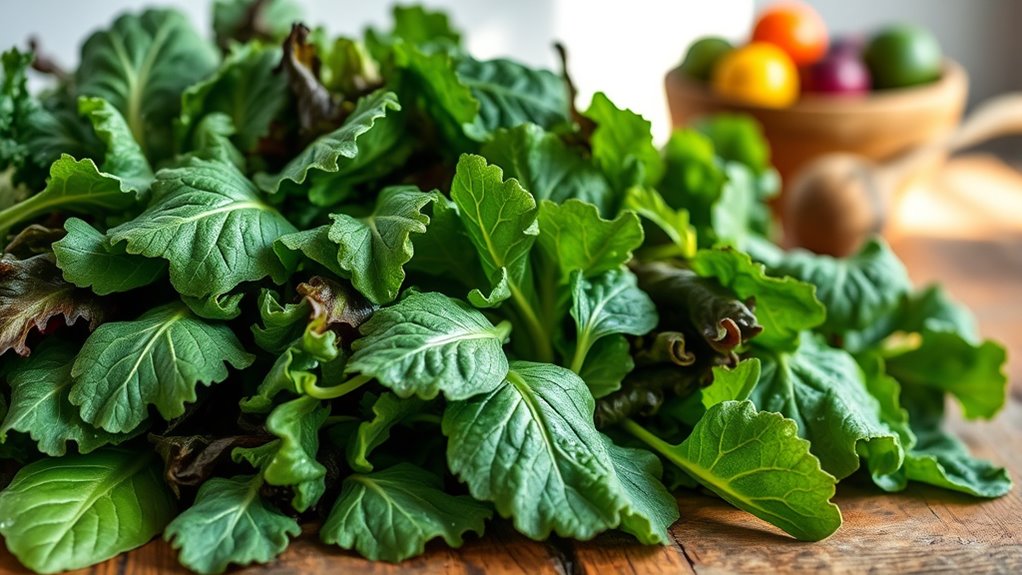
Incorporating leafy greens into your meals not only adds flavor and variety but also brings a wealth of health benefits.
These vibrant vegetables are packed with essential nutrients that support your overall well-being:
- High in vitamin K: Leafy greens like endive provide 97% of your daily value, which is vital for blood clotting and bone health. Furthermore, incorporating educational toys into your child’s playtime can enhance their cognitive development. Consuming leafy greens can also aid in maintaining kidney health due to their high nutrient density. Additionally, many leafy greens are low in calories, making them an excellent choice for weight management. Regular consumption of these vegetables can also contribute to early detection of health issues, as a balanced diet supports overall health.
- Rich in antioxidants: Compounds like kaempferol in arugula help combat oxidative stress and reduce inflammation.
- Support heart health: Regular consumption of leafy greens is linked to lower cholesterol levels, reducing the risk of chronic diseases.
Additionally, their excellent source of dietary fiber aids digestion and promotes satiety, helping with weight management. Including fruits and vegetables in your diet can further enhance these benefits.
Embrace leafy greens for a healthier you!
Seasonal Availability of Leafy Greens
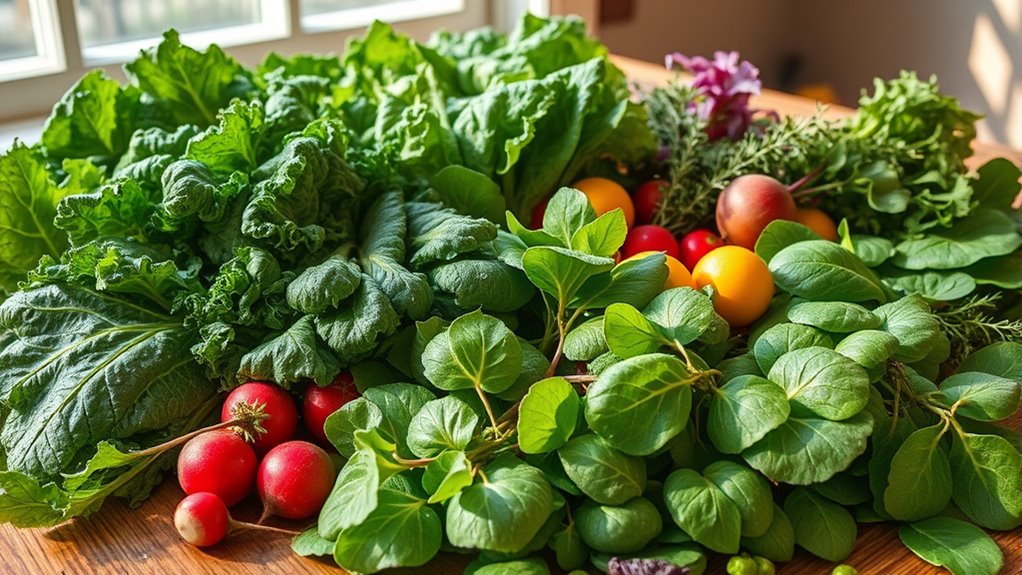
When you think about leafy greens, it’s important to know that their availability changes throughout the year. Seasonal greens offer a variety of flavors, and knowing when to buy them can enhance your meals.
Here’s a quick guide on availability:
| Season | Leafy Greens |
|---|---|
| Winter | Kale, Collard Greens |
| Spring | Spinach, Arugula |
| Summer | Watercress, Lettuce |
| Fall | Swiss Chard, Beet Greens |
| Year-Round | Mustard Greens |
Visiting your local farmers’ market can guarantee you get the freshest, seasonal leafy greens. You’ll find heartier greens in cooler months, perfect for warming dishes, while tender greens shine in spring and summer salads. Enjoy the variety!
Tips for Storing Leafy Greens
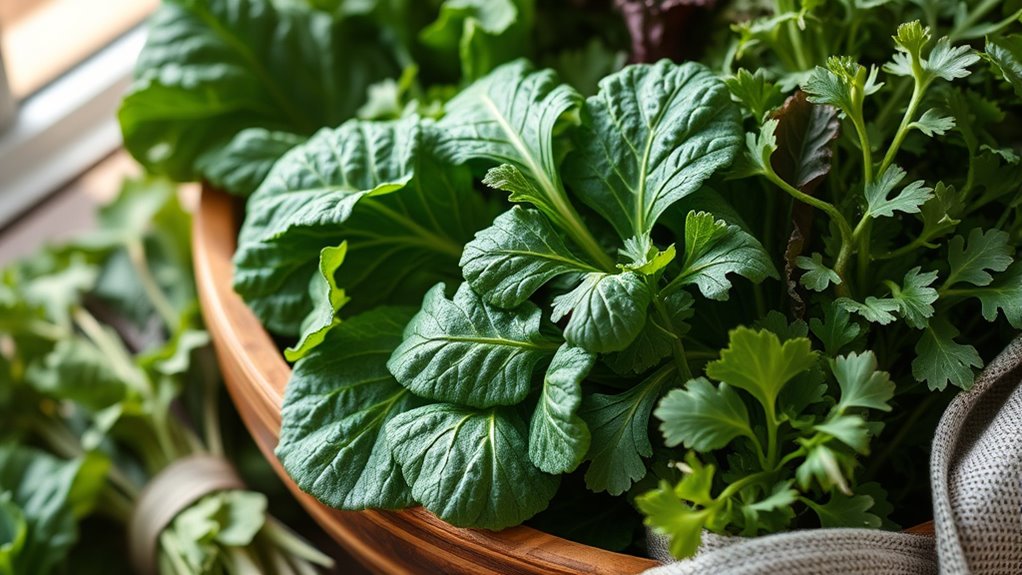
To keep your leafy greens fresh and flavorful, proper storage is crucial. Here are some key tips to follow:
- Store leafy greens in the refrigerator, ideally in a perforated plastic bag to allow airflow and maintain freshness.
- Wash leafy greens only before use to prevent spoilage; excess moisture can lead to quicker decay.
- For ideal nutrient retention, aim to consume your greens within a week.
Additionally, keep your greens in the crisper drawer of the fridge to maintain humidity and prevent wilting.
If you want to store leafy greens for longer, consider blanching and freezing them to preserve their nutritional value.
Following these tips will guarantee you enjoy your leafy greens at their best!
Delicious Leafy Green Recipes to Try
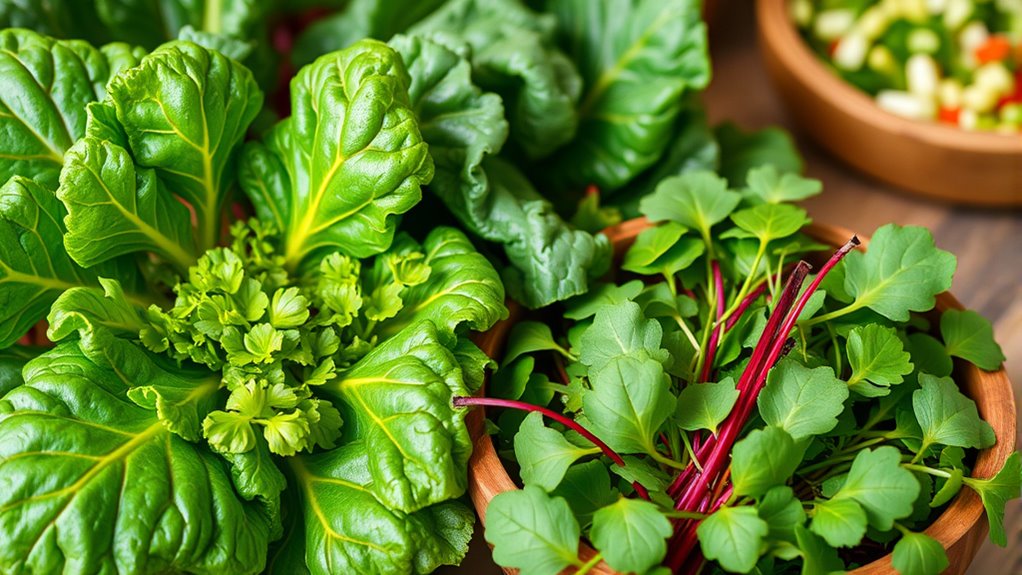
Ready to elevate your meals with leafy greens?
You can whip up flavorful salad combinations, toss in quick smoothie boosters, or simmer hearty soups that highlight these nutritious ingredients.
Let’s explore some delicious recipes that make it easy to enjoy greens in every bite!
Flavorful Salad Combinations
If you’re looking to elevate your salad game, combining leafy greens with a variety of flavorful ingredients can create delightful and nutritious meals.
Here are some tasty combinations you’ll love:
- Kale, apples, and goat cheese: This mix offers a satisfying crunch while packing vitamins A, K, and C.
- Arugula, roasted beets, and walnuts: Enjoy a revitalizing salad rich in antioxidants and healthy fats.
- Spinach, strawberries, and feta: This vibrant pairing boosts vitamin C and calcium for a nutritious treat.
Don’t forget to try a hearty option with collard greens, quinoa, and cherry tomatoes dressed in lemon vinaigrette.
Whatever you choose, these flavorful combinations will keep your salads healthy, crunchy, and bursting with flavor!
Quick Smoothie Boosters
While smoothies are often packed with fruits, adding leafy greens can greatly enhance their nutritional profile without compromising on taste. Spinach is a fantastic option, offering 16% of your daily iron needs in just one cup, helping prevent anemia.
Kale and Swiss chard are rich in vitamin K, while collard greens boost calcium, essential for bone health. For a unique twist, try arugula; its peppery flavor packs antioxidants like kaempferol, known for its anti-inflammatory benefits.
Leafy greens are low in calories and high in fiber, making them perfect for weight management. Experiment with different combinations to create delicious, nutrient-dense smoothies that keep you feeling satisfied and energized throughout the day!
Hearty Soup Ideas
Adding leafy greens to your meals doesn’t stop at smoothies; they can transform hearty soups into nutritious, satisfying dishes. Incorporating greens like collard greens and Swiss chard isn’t just about flavor; it’s about boosting your heart health and overall nutrition. Additionally, consider enriching your soups with chia seeds to enhance their omega-3 content and support heart health.
Here are three delicious soup ideas to try:
- Greens and Beans Turkey Soup: A comforting winter dish packed with turkey and your favorite leafy greens.
- Slow-Cooker Spinach Bean Soup: A convenient comfort food featuring navy beans and seasonal peppers.
- Artichoke Spinach Lasagna: A hearty, cheesy delight that showcases greens in a deliciously comforting way.
Try these recipes, and enjoy the benefits of leafy greens while indulging in your favorite hearty soups!
Leafy Greens and Weight Management
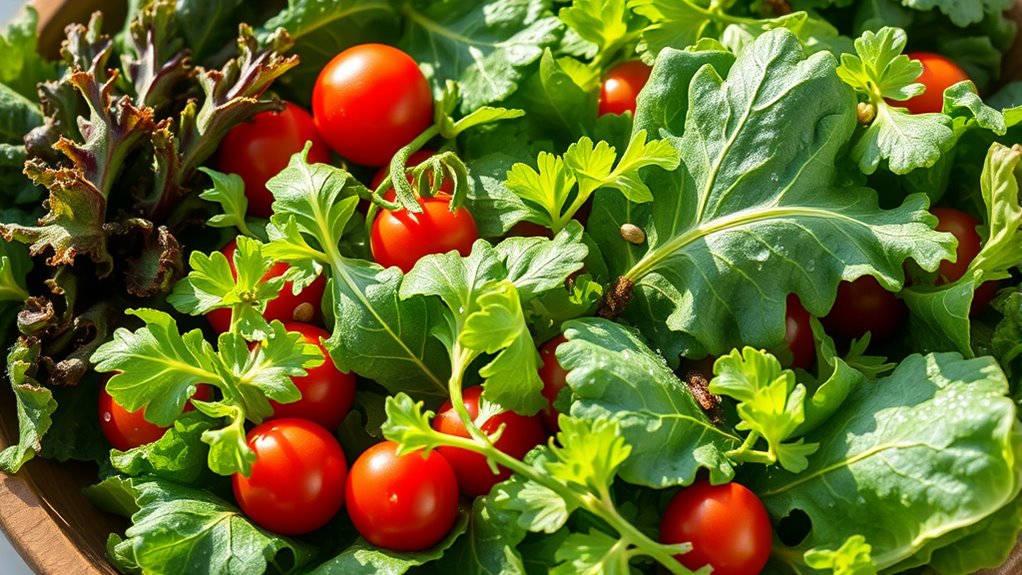
Leafy greens are a powerhouse for weight management, packing a punch with low calories and high fiber. By incorporating these greens into your meals, you can enjoy a satisfying and nutrient-dense diet that helps control calorie consumption.
Their high fiber content promotes satiety, keeping you feeling full longer and reducing overall food intake. Studies show that people who eat more leafy greens tend to have lower body weight and a decreased risk of obesity-related diseases.
Plus, replacing higher-calorie ingredients with leafy greens effectively lowers your overall calorie consumption, making it easier to maintain a calorie deficit for weight loss.
How to Incorporate Leafy Greens Into Your Meals
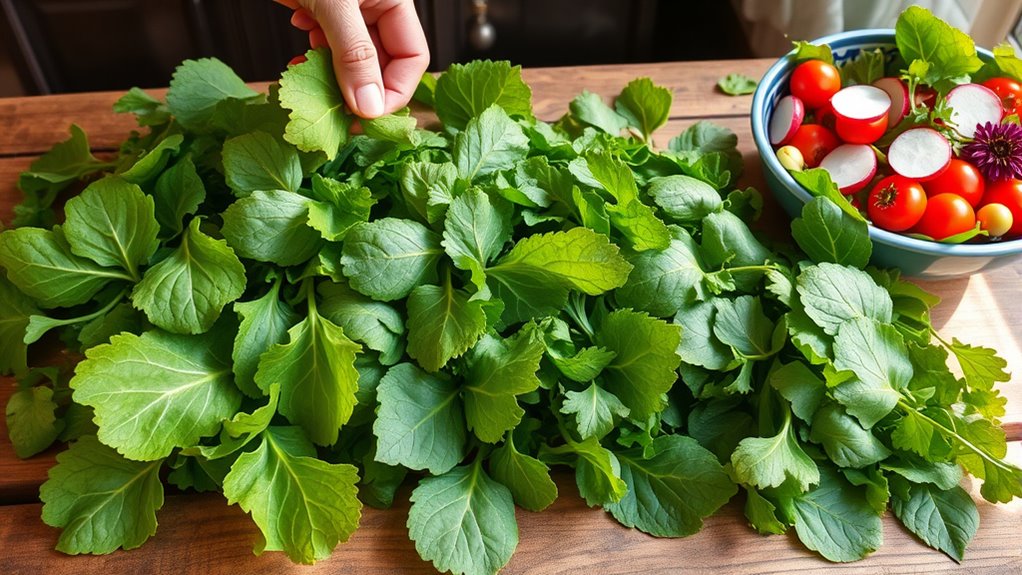
Incorporating leafy greens into your meals can be a game changer for both flavor and nutrition. You can easily add them to your diet in various delicious ways:
Adding leafy greens to your meals enhances both flavor and nutrition, making healthy eating enjoyable and easy.
- Smoothies: Blend spinach or kale with fruits to mask their flavor while boosting nutrition.
- Salads: Use a mix of greens like arugula and romaine as a base, aiming for 1-2 cups per serving.
- Sautéed: Add Swiss chard or collard greens to pasta dishes or grain bowls for extra fiber and vitamins.
Don’t forget to experiment! Use large leafy greens in wraps instead of tortillas, or toss chopped greens into soups and stews to enhance flavor and nutrition.
Incorporate these ideas, and you’ll enjoy the benefits of leafy greens in no time!
Frequently Asked Questions
What Is the Healthiest Leafy Green to Eat?
When you’re looking for the healthiest leafy green to eat, it’s hard to pick just one. Arugula packs a punch with antioxidants, while kale offers a wealth of vitamins.
Spinach’s iron content is essential for preventing anemia, and collard greens support bone health with their high calcium levels.
Instead of settling for one, consider mixing them together. This way, you’ll maximize your nutrient intake and enjoy a variety of flavors and textures in your meals.
How Do You Eat Leafy Greens if You Don’t Like Them?
Ever thought about how you can enjoy leafy greens despite not liking them?
Start by blending them into smoothies with sweet fruits like bananas or berries to mask their taste. You can also use large leaves as wraps or sauté them with garlic and spices for added flavor.
Try adding greens to soups or stews, too; they’ll cook down and blend in nicely.
Experimenting with different varieties can make your meals more exciting!
What Are the Easiest Leafy Greens to Eat?
When you’re looking for easy leafy greens to eat, consider options like spinach or baby kale. Their mild flavors blend well into salads or smoothies without overpowering other ingredients.
Romaine lettuce offers a crunchy texture, perfect for adding freshness to dishes. Watercress brings a peppery kick that enhances salads and sandwiches.
Don’t forget beet greens; they’re delicious raw or cooked, adding a unique taste to your meals. Enjoy experimenting with these versatile greens!
What Is the Healthiest Vegetable to Eat Every Day?
The healthiest vegetable to eat every day is subjective, but leafy greens often top the list. They’re packed with vitamins, minerals, and fiber, making them a fantastic choice for overall health.
By incorporating greens like spinach or kale into your meals, you boost your nutrient intake and support heart health. Aim for at least 1 1/2 to 2 cups weekly to reap the benefits.
Don’t forget to mix them up for variety and added benefits!
Conclusion
Incorporating leafy greens into your meals isn’t just a step toward better health; it’s a delightful journey that enriches your plate and palate. These vibrant greens invite you to explore a world of flavors and textures while nurturing your body. So, let’s not just eat our greens—let’s embrace them as allies in our quest for wellness. By making them a regular part of your diet, you’re not just feeding yourself; you’re cultivating a flourishing future.
